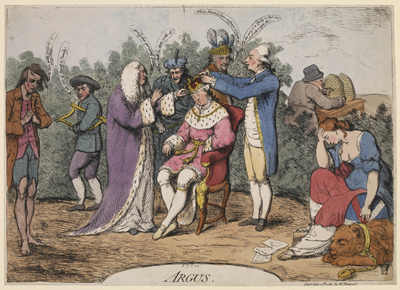Argus
In classical mythology, Argus represented eternal vigilance. He was a giant with many eyes so that even if some eyes slept, others continued to be awake and watchful. Applied to this print, the title is clearly ironic. The King who should be watching out for the interests of his people is asleep on his throne, and likely to become a victim of designing factions and former allies, each with its own agenda.

© Trustees of the British Museum
These false friends are mostly identified by national stereotypes. The Irish are represented by a figure with a harp. The Scot, Lord Bute, is shown wearing the tartan. Americans are represented by a figure with a feathered headdress, and the Dutch are represented by the well-fed peasant with his distinctive Dutch cap, making off with the honey.
As is often the case, the arrangement of figures is part of the meaning. There are three groups of figures. The first group forms a kind of inner circle surrounding the King. Three of the four figures are Scots and all have designs upon the crown. Lord Bute who has already removed the sceptre from the King's hand, now asks about the crown. "What shall be done with it?" William Murray, Lord Mansfield, identified by his speech and the robes of the Chief Justice, replies "Wear it Your sel my Leard." Not to be outdone, another Scot, with an interest in restoring the Stuarts to the throne, has already reached for the crown, saying "No troth I'se carry it to Charly & hel not part with it again Mon!" The fourth figure in the group represents America which has begun to turn away and consequently has no interest in who wears the crown: "We in America have no Crown to Fight for or Loose."
The figure of America provides a segue to the second circle of figures who are both farther from the central figure of the King and mostly turned away from him. They represent Ireland and the Dutch Provinces. With the start of the American war for independence and the diminished British presence in Ireland, the Irish had begun to organize local militias, forming the Irish Volunteers in 1778 to maintain order and defend against potential attack from France. Their growing strength enabled them to assert greater independence from England ("I'le take Care of Myself & Family") eventually winning legislative independence in 1782. Meanwhile the Dutch Provinces, which were officially neutral in the American war, had been selling munitions to both the French and Americans and using the Dutch controlled Carribean islands like St. Eustatius as a lucrative pass through for contraband goods and communications from Europe to the rebellious American colonists.
The results of all this upon Britain can be seen in the outer circle of figures, portraying Britannia and the typical British citizen. Britannia is shown mourning with a fettered British lion. And on the opposite end, farthest from the King (and apparently from his concern), the typical British citizen is shown ragged and impoverished, lamenting "I have let them quietly strip me of every Thing."
At this stage of his career, Gillray is starting to engage in political commentary, but it is of a very general nature, based on overall trends and national sterotypes rather than the specific, timely and immediate events he relies upon later.
Sources and Reading
- Commentary from the British Museum on Argus
- Draper Hill, The Satirical Etchings of James Gillray, 1976, #2
- "Argus Panoptes," Wikipedia
- "William Murray, 1st Earl of Mansfield," Wikipedia
- "John Stuart, 3rd Earl of Bute," Wikipedia
Comments & Corrections
NOTE: Comments and/or corrections are always appreciated. To make that easier, I have included a form below that you can use. I promise never to share any of the info provided without your express permission.